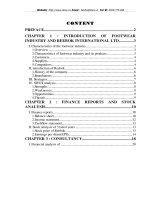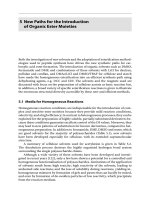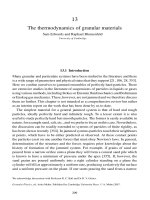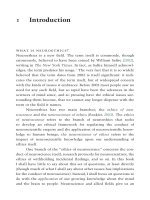Introduction of Granular Physics
Bạn đang xem bản rút gọn của tài liệu. Xem và tải ngay bản đầy đủ của tài liệu tại đây (72.83 KB, 9 trang )
4 Introduction
largely conceptual, this fills an important void in a theory of seminal importance in
the physics of granular media.
The statistical mechanics framework of Edwards has been remarkably successful
in various applications. It was used in its earliest form to examine the problem of
segregation when a mixture of grains of two different sizes was shaken [16, 17].
An equivalent granular ‘Hamiltonian’ was written down and solved to increasing
levels of sophistication. At the simplest level, the prediction of this model was total
miscibility for large compactivities, and phase separation for lower compactivities.
At a higher-order level of solution corresponding to the eight-vertex model of
spins [18], the prediction for the ordered phase was more subtle: below a critical
compactivity, segregation coexists with ‘stacking’, where some of the smaller grains
nestle in the pores created by the larger ones. While it has so far not proved possible
to carry out reliable three-dimensional investigations of granular packings at the
particulate scale, experiments on concentrated suspensions for high Peclet number
(where Brownian motion is greatly diminished) [19] support these predictions.
In our discussions so far, we have said little about the frictional forces that hold
dry cohesionless powders together; the first attempt to formulate a macroscopic
friction coefficient is attributed to Coulomb [20], who equated it to the tangent of
the angle of repose, by defining it to be the ratio of shear and normal stresses on an
inclined pile of sand. While the work of Bagnold [5, 6] made it clear that frictional
force varied as the square of the shear rate for grain-inertial flow in the regime of
rapid shear, it has long been recognised that the nature of the frictional forces in the
quasistatic regime is complex; the frictional force between individual grains in a
powder can take any value up to some threshold for motion to be initiated [21], so
that considerations of global stability reveal little about the nature of microscopic
stick–slip mechanisms [22, 23]. The proper microscopic formulation of intergrain
friction remains an outstanding theoretical challenge.
1.2 Granular flow through wedges, channels and apertures
The flow of sand through hoppers [21] or through an hourglass [24] has been well
studied, in particular to do with the dependence of the flow rate on the radius of
the aperture, on the angle of the exit cone and on the grain size. Interest in this
subject was rekindled by the experiments of Baxter et al. [25], who examined the
flow of sand through a wedge-shaped hopper using X-ray subtraction techniques.
They demonstrated that for large wedge angles, dilatancy waves formed and prop-
agated upwards to the surface; their explanation was that these propagating regions
were due to progressive bridge collapse. Thus, regions of low density trapped
under bridges ‘travel upwards’ when they collapse due to the weight of oncoming
material from the top of the hopper. This phenomenon is reversed for the case of
1.3 Instabilities, convection and pattern formation 5
small wedge angles, when waves propagate downwards and disappear altogether
for totally smooth grains. Evesque [26] has also reported a related phenomenon
in his observations of vibrated hourglasses; for large amplitudes of vibration, he
observed that flow at the orifice was stopped. Naive reasoning would suggest that an
increased flow might result as a consequence of the greater fluidisation of sand in the
large-amplitude regime – the observation to the contrary confirms the well-known
phenomenon of jamming [27, 28].
Theoretical approaches to this subject have been greatly restricted by their inabil-
ity so far to deal with the fundamentally discrete and discontinuous aspects of
granular flow through narrow channels. While existing kinetic theory approaches
(see Chapter 12) can be adequate to cope with regions of the wedge where flow
exists, they are inadequate for the regions where flow, if it exists, is quasistatic; an
added complication from the theoretical point of view is that the transition between
these two phases occurs discontinuously. Also, for narrow channels and orifices,
the discreteness of the grains is very important and continuum approaches based
on fluid mechanics are not really appropriate: despite this limitation, the continuum
calculations of Hui and Haff [29] were able to reproduce experimentally observed
features of granular flow in narrow channels, such as the formation of plugs. They
predicted that for small inelastic grains, plug flow develops in the centre of the
channel, with mobile grains restricted to boundary layers; for large elastic grains,
on the other hand, plug flow does not occur at all, although the flow rate decreases
near the centre. Caram and Hong [30] have carried out two-dimensional simulations
of biased random walks on a triangular lattice based on the notion that the flow of
grains through an orifice can be modelled as an upward random walk of voids; this
yields a flavour of plug flow and bridge formation. Finally, Baxter and Behringer
[31] have demonstrated the effects of particle orientation (see also Behringer and
Baxter [32] for a fuller description); their cellular automaton (CA) model includes
orientational interactions, whose results are in good agreement with their experi-
ments on elongated grains. The results of both simulation and experiment indicate
that elongated grains align themselves in the direction of flow, with the upper free
surface exhibiting a series of complex shapes. More recent work on bridges [33] as
well as on grain shapes [34, 35], will be discussed in detail in subsequent chapters.
1.3 Instabilities, convection and pattern formation
in vibrated granular beds
The occurrence of convective instabilities in vibrated powders is among a class
of familiar phenomena (see, for example [36]) that have been reexamined by
several groups [37, 38]. When an initially flat pile of sand is vibrated vertically
with an applied acceleration such that >g, the acceleration due to gravity, a
6 Introduction
spontaneous slope appears, which approaches the angle of repose θ; this is termed
a convective instability, since it is then maintained by the flow down the slope, and
convective feedback to the top. However, there is still considerable doubt about the
mechanisms responsible for the spontaneous symmetry breaking associated with
the sign of the slope. On the one hand, it seems very plausible that the presence of
rogue horizontal vibrations (which are very difficult to eradicate totally) could be
responsible for transients pushing up one side of the pile; the symmetry breaking
thus achieved would lead to the resultant slope being maintained by convection
in the steady state. Equally, a mechanism due to Faraday [39] has been invoked
[38] to explain this, which relies on the notion that air flow in the vibrated pile is
responsible for the initial perturbation of the grains and the consequent appearance
of the ‘spontaneous’ slope. Finally, it is possible to draw analogies with the work of
Batchelor [40] on fluidised beds, which suggests that one of the key quantities lead-
ing to instabilities in those systems is the gradient diffusivity of the grains, related
to differences in their spatial concentration; however, for powders well below the
fluidisation threshold, where interstitial fluid is expected to play a more minor role
than in conventional fluid-mechanical systems, such analogies should be pursued
with caution.
An associated problem is the extent to which the vibrated bed can indeed be
regarded as fluidised in the sense required for the Faraday mechanism. While kinetic
theory approaches suggest that a vibrated sandpile is more fluidised at the bottom
than at the top [4], experiments [41] suggest the opposite; this scenario, i.e. that the
free surface of a pile is more loosely packed than its base, is one that makes much
more intuitive sense.
It is possible that the resolution of this controversy lies in the interpolation of
granular temperatures discussed in [42]. In the regime of large vibration or when
piles are loosely packed, grains can undergo a kind of Brownian motion in response
to the driving force, so that the use of kinetic theories based on the concept of a
conventional granular temperature is not inappropriate; it is then also conceivable
that the extent of fluidisation is greatest at the base where the driving force is
applied. On the other hand, for denser piles as used in the experiments of Evesque
[41], providing the amplitude of vibration is not too large, the use of kinetic theory
is limited, and the effective temperature is more likely to be the compactivity [15];
in such regimes, one would expect to see denser packings at the base which would
then move like a plug in response to vibration, allowing for the greatest agitation
to be felt at the free surface. The experiments of Zik and Stavans [43], where the
authors measured the friction felt by a sphere immersed in a vibrated granular bed
as a function of height from the base and applied acceleration, lend support to this
scenario. They show that in a boundary layer at the bottom of the cell, the friction
decreases rapidly with height, whereas it is nearly constant in the bulk; however, the
1.3 Instabilities, convection and pattern formation 7
size of this boundary layer decreases sharply with increasing acceleration, ranging
from the system size at = 1 to the sphere size at higher accelerations. They
conclude that for large accelerations, grains are in a fluidised state, and respond as
nearly Brownian particles; while for small accelerations and a denser packing, the
presence of a systemwide boundary layer indicates strongly collective behaviour,
with free particle motion restricted to the surface.
The phenomenon of convective instability has also been explored by computer
simulations. Both Taguchi [44] and Gallas et al. [45] have employed granular
dynamics schemes to simulate the formation of convective cells in two-dimensional
vibrated granular beds containing a few hundred particles. These simulations are
based on the molecular dynamics approach but they include parametrised interpar-
ticle interactions which model the effects of friction and the dissipation of energy
during inelastic collisions. The form of this interaction, which allows a limited
number of particle overlaps, precludes a direct quantitative comparison between
the simulations and the behaviour of real granular materials.
However, it is clear that convection in a two-dimensional granular bed can be
driven by a cyclic sinusoidal displacement imposed on the (hard) base of the simu-
lation cell. In the steady state, a map of the mean particle velocity against position
(in the frame of the container) shows two rolls which flow downwards next to the
container walls and upwards in the centre. Although experiments have concentrated
on the link between convection and heap formation, these simulations show the two
phenomena as separate; a causal link between these two effects, if one exists, must
be pursued in more realistic three-dimensional simulations. It is also clear that better
models of the forces transmitted from the vibration source through grain contacts
to the pile surface are necessary for the understanding of extended flow patterns
in disordered granular systems. These issues will be further discussed later in this
book.
For two-dimensional simulations containing a few hundred particles, the details
of the driving force are paramount in determining the strength and the quality of the
convective motion. Gallas et al. [45] show that there is a special (resonant) driving
frequency for which convection is strongest and that the cellular pattern disappears
if the vibration displacement amplitude is small. Taguchi [44] has shown that, for
small vibration amplitude or large bed depth, convection is limited to an upper,
fluidised layer while lower particles respond to the excitation, in large part, as a
rigid body. The depth of the fluidised region increases with the vibration strength.
Taguchi has identified the release of vertical stress during the vibrational part of
the shake cycle as the origin of the convective motion. This occurs for acceleration
amplitudes that are above a critical value ( ≈ 1).
For larger accelerations yet, experiments report more and more compli-
cated instabilities; Douady et al. [38] have reported period-doubling instabilities
8 Introduction
leading to the formation of spatially stationary patterns. Pak and Behringer [46]
also observe these standing waves, and find in addition higher-order instabilities
corresponding to travelling waves moving upward to the free surface. In some cases
a bubbling effect is observed, where voids created at the bottom propagate upwards
and burst at the free surface, indicating that the bed is fluidised. One of the most
striking experimental observations is the oscillon, reported by Umbanhowar, Melo
and Swinney [47–49]. While there is as yet an insufficient theoretical understanding
of these difficult problems, it is clear [50] that the applied acceleration , which
has been used canonically as a control parameter for vibrated beds, is inadequate
for their complete characterisation. This is corroborated by the experiments of Pak
and Behringer [46], who point out that the higher-order instabilities they observe
occur only for large amplitudes of vibration at a given value of the acceleration .
The previous use of on its own was related to hypotheses [37] that a granular
bed behaved like a single entity, e.g. an inelastic bouncing ball, in its response to
vibration; while is indeed the only control parameter for this system [51], the
many-body aspects of a sandpile and its complicated response to different shear and
vibratory regimes defy such oversimplification [52, 53]. We suggest, therefore, that
competing regimes of amplitude and frequency should be explored for the proper
investigation of pattern formation and instabilities in vibrated granular beds.
1.4 Size segregation in vibrated powders
Still keeping the convection connection, but in the context of segregation, we men-
tion the work of Knight et al. [54] which identified convection processes as a cause of
size segregation in vibrated powders. Size segregation phenomena, in which loosely
packed aggregates of solid particles separate according to particle size when they
are subjected to shaking, have widespread industrial and technological importance.
For example, the food, pharmaceutical and ceramic industries include many pro-
cesses such as the preparation of homogeneous particulate mixtures, for which
shaking-induced size segregation is a concern. An assessment of the particulate
mechanisms that underlie a segregation effect and of the qualities of the vibrations
which constitute the driving forces is thus essential in these situations [55].
The convection-driven segregation proposed by Knight et al. [54] is clearly dis-
tinct from previously proposed segregation mechanisms (see below) which rely
substantially on relative particle reorganisations. In a convection flow pattern all
the particles, large and small, are carried upwards along the centre of each roll, but
only particles which have sizes smaller than the width of the downward moving
zone at the roll edges will continue in the flow and complete a convection cycle.
Those particles that are larger than this critical size remain trapped on the top of
a vibrating bed, and therefore segregation is observed. In the simplest case, such









